October 2024
Inside This Issue
Standards & SAG Updates:
 It’s another somewhat quiet month in terms of significant new announcements from TJC in the October issue of Perspectives. It appears to us that the prepublication standards for laboratories that take effect January 1, 2025, and the revised survey activity guide and document lists for home care are the most significant changes.
It’s another somewhat quiet month in terms of significant new announcements from TJC in the October issue of Perspectives. It appears to us that the prepublication standards for laboratories that take effect January 1, 2025, and the revised survey activity guide and document lists for home care are the most significant changes.
The laboratory announcement discusses even more rigorous requirements that will require more proficiency testing, and in some cases higher pass rates. The home care survey document list changes are the result of CMS changes that were announced in QSO-24-07. There is also a new August version of the Home Care Agency Survey Activity Guide (SAG) that should be downloaded and reviewed.
Perspectives also discusses a new Emergency Management chapter for laboratories, but as most of our readers are from larger accredited organizations that also have laboratories, this new chapter will not be applicable. This makes sense because the laboratory is not stand alone, but rather part of a larger healthcare organization that is already being reviewed against newer emergency management standards.
The Perspectives announcement does advise, for example for a hospital-based lab, that the laboratory should be prepared to discuss how they collaborate with the larger EM planning of the hospital and how lab-specific issues are addressed.
 Off Site Review Option for DSC:
Off Site Review Option for DSC:
Perspectives has an article describing that beginning in 2025, TJC will offer an off-site survey option for some Disease Specific Care (DSC) programs. An off-site review will be an option on every other, or every second certification review. This off-site review will only be available for what TJC calls their core programs as well as Advanced Heart Attack Ready, Advanced Acute Stroke Ready Certifications, Palliative Care, and Health Care Equity Reviews.
Other advanced programs including Medication Compounding, Patient Blood Management, Comprehensive Cardiac Care Center, and Maternal Levels of Care Verification are not eligible for an off-site review.
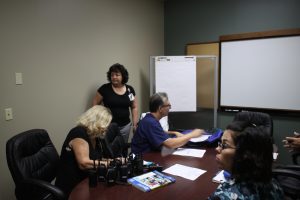 Continuity of Operations Plan (COOP):
Continuity of Operations Plan (COOP):
This month’s Consistent Interpretation column discusses EM.13.01.01, EP 1 which establishes the requirement for a Continuity of Operations Plan (COOP) as part of your overall emergency management plan. TJC reports that last year’s noncompliance rate was only 1.3%. That seems very good as this subject used to be confusing to many organizations and was a slightly more frequent omission.
The guidance/interpretation section is succinct. The EP requires that the organization’s leaders identify and prioritize the services and functions that are considered essential or critical for maintaining operations. The guidance then advises that the COOP address (i.e., the COOP has 6 delineated sections or headers outlining the) 6 “essential elements” which include:
- Administrative and vital records
- Information technology
- Financial services
- Security systems
- Communications
- Essential and critical building operations

USP Chapter 797:
The lead article in this month’s issue of EC News is a high-level summary of what some of the changes are in the “new version” (11/1/2023) of USP Chapter 797. While your pharmacy leaders should already be aware of this summary information, the concise article will be a useful primer for administrative or facilities personnel who supervise or work with pharmacy to maintain the sterile compounding environment as well as key committees that may touch upon these issues including Pharmacy and Therapeutics, Environment of Care, or Infection Prevention. The article also contains a link to a much more detailed document from the American Society of Health System Pharmacists that explains the key differences between the 2008 and 2023 versions of Chapter 797. This ASHP summary can be accessed using the following link:
Physical Environment Most Frequently Scored:
EC News also has an excellent article on the 5 most frequently scored physical environment standards/elements of performance. The percentage of hospitals scored noncompliant is huge, ranging from 41%-63% failure rates.
These 5 most difficult elements of performance and their respective noncompliance rates are as follows:
- 02.06.01, EP 1 63% noncompliance rate
- 02.05.01, EP 9 58% noncompliance rate
- 02.05.05, EP 6 53% noncompliance rate
- 02.02.01, EP 5 46% noncompliance rate
- 02.06.01, EP 26 41% noncompliance rate
Fortunately, the EC News article also includes a brief summary, some photographs and examples of what commonly causes this high level of noncompliance.
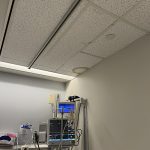 EC.02.06.01, EP 1
EC.02.06.01, EP 1
We have talked about this EP previously in this newsletter as a “catch all” requirement where almost any safety defect in the physical environment can be scored. This could be stained ceiling tiles, chipped walls, or bathroom emergency call cords that are tied up around a grab bar and unreachable by a patient who might have fallen. As you make environmental rounds you need to schedule repairs for all the minor defects found in the building.

EC.02.05.01, EP 9
This EP is more specific and requires correct labeling of all utility system controls. This can include gas lines, shut off valves, and circuit breakers. The fire alarm circuit breaker should be dedicated and labeled in red. In addition, each circuit breaker must be labeled to identify what it controls. A very common finding is a circuit breaker that is unlabeled and thus are presumed to not be in use, but it is in the on position. If it’s on, but unlabeled it might actually be controlling something important, or it could be in the on position inappropriately. Either way it is a failure in the requirement. As you do environmental rounding, these breakers should be checked to verify that labels have not fallen off, or breakers that are genuinely not in use are not in the on position.
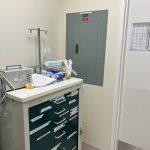 EC.02.05.05, EP 6
EC.02.05.05, EP 6
This EP requires that the hospital inspect, test and maintain non-high-risk utility system components on the inventory and that the completion date and results of activities are documented. This sounds somewhat nonspecific, and many readers may not know what this entails. It could be as simple as blocking electrical panels. Commonly it can also be open junction boxes that contain live wiring, where someone has left the cover off. It may also be that you are missing battery powered task lighting for the generator that an operator may need if the generator has failed to start.
EC.02.02.01, EP 5
This EP states that the hospital should minimize risks associated with selecting, storing, transporting, using and disposing of hazardous chemicals. While there are many aspects to safe use of hazardous chemicals, the one very problematic issue we see often is related to eye wash stations. There are a multitude of errors that can occur with eyewash stations including:
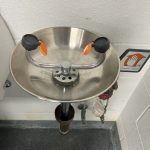
- Failure to have an eye wash station in a location where hazardous chemicals are used.
- Failure to inspect or properly inspect the eyewash station weekly in accordance with ANSI standard Z358.1(2014).
- Placement of an eyewash station behind a locked door.
- Staff don’t know how to activate and use the eyewash station.
- Leaving the caps off the eye nozzles allowing dust and lint to collect.
- Staff manually removing the caps prior to demonstration of use.
- Eyewash station water not tepid, too hot or too cold due to not having a mixing valve.
- Having a small bottle eyewash, where corrosive chemicals are in use, requiring a plumbed eyewash.
The one key to compliance is ensuring you have a plumbed eyewash wherever corrosive chemicals or formaldehyde are in use. This requires knowing what chemicals are routinely in use and controlling what chemicals different area managers and contractors are permitted to purchase and leave in these locations. As consultants we do see this being a significant issue, particularly in outpatient locations that independently purchase chemicals or cleaning service contractors bring in and leave corrosive chemicals.
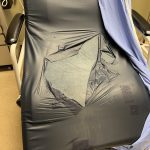 EC.02.06.01, EP 26
EC.02.06.01, EP 26
This EP is conceptually very similar to the first EP we discussed as this one is also a catch all, but a catch all for environmental defects that you might see in furnishings or equipment. For example, torn seat cushions, torn stretchers, rusted chair legs, dust build up all of which make that furnishing “uncleanable,” posing an infection hazard.
Fire Response Plan:
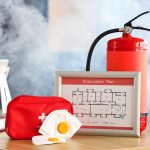
EC News also has a good article on content requirements in your fire response plan. However, we also heard TJC announce at their 2024 Executive Briefings seminar that they were going to eliminate the EC chapter management plans including fire. Before you spend time and energy enhancing your plan you might want to wait and see if CMS actually authorizes this change and TJC actually implements this change. The new chapter is anticipated to be released midyear 2025. Reportedly there are also plans to combine the EC and LS chapters into one Physical Environment chapter.
Suicide Prevention:
TJC and CMS have been enhancing their suicide safety expectations since 2019, but as things evolve and survey focus changes it is valuable to review what the current expectations really are. Well, this month’s EC News has a good summary refresher on suicide prevention expectations for hospital and behavioral health accredited organizations in their Environment of Care Q+A section.
An important requirement in both behavioral health and hospital organizations is the need to perform an environmental risk assessment to identify features in the environment that could prove hazardous to patients. This is an area whereas consultants we find many organizations miss including all the potential ligature hazards that an outside surveyor might identify.
One potential reason for this is that many people think of their own experience, and if no one ever tried to hurt themselves with a fixture, it is assumed it’s not really a hazard. Sadly, patients are remarkably innovative at identifying unique ways of attempting suicide, using devices and methods that may not have ever been tried at your organization, but are reported in the literature. Thus, there is great value in not starting to identify ligature hazards with a blank sheet of paper, but rather use one of the many tools developed by expert groups such as ASHE, ACHC, or the Veterans Administration. These tools identify a wide array of potential hazards and then as you tour your units, you look to see if you have any of these potential problems, rather than trying to personally identify all the potential hazards.
The EC News article also reminds us that unsupervised areas such as bedrooms and bathrooms should be ligature “resistant” without any points of attachment that could support a patients weight. In addition, these areas must be free of other hazards such as plastic garbage bags that are used for suffocation, or hazardous chemicals and sharps. Lastly if you have potential hazards in other areas, such as group rooms, you must mitigate those hazards through supervision, along with self-closing and self-locking doors when these areas are not staffed.
Once you have a good environmental risk assessment, keep it alive by updating it at least once every year as hazards are removed, fixtures are replaced, or the behavioral health literature informs you of additional lessons learned from sentinel events. Do share this EC News article with staff responsible for the behavioral health environment and keeping patients safe.
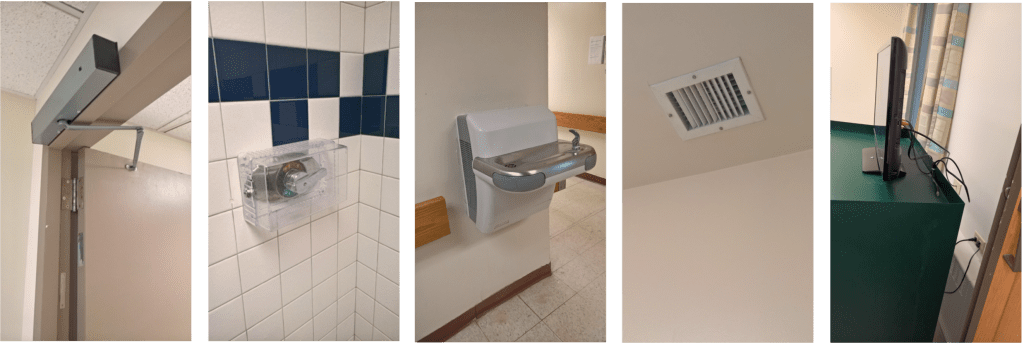
ACHC: Resources:
Like many accreditors, ACHC has a significant schedule of educational programs, seminars and publications that are available for purchase. In addition, they have an extensive inventory of free webinars available on their website that can be reviewed at your convenience, including the ones we mentioned several months ago by our very own Jennifer Cowel, RN, MHSA and Gloria Legere, RN, MS, JD, CPHQ, CISCI.
DNV: Symposium:
The annual DNV Healthcare Symposium is being held later this month in Charleston, SC on October 21-24. The agenda for the symposium can be viewed here.
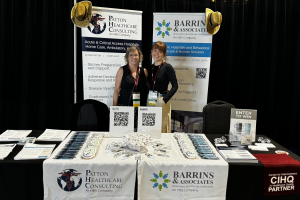 CIHQ: Summit:
CIHQ: Summit:
CIHQ held their Accreditation and Regulatory Summit this past month and presented on their most frequently scored standards and those issues which most often lead to a Medicare Condition Level finding. We hosted a booth at this conference and Julia Finken, RN, BSN, MBA, CPHQ, CLSSMBB and Brooke Jones, BA were in attendance representing both Patton and Barrins.
There is significant similarity in the nature of most of these findings to other accreditors and CMS findings, but this serves as a reminder to focus on these frequently reported and difficult standards. We did note that respiratory services and discharge plans to post-acute providers appear unique in comparison to others, but that may be good advice to self-assess those functions before other accreditors begin to also ramp up in these areas.
The below data represents the noncompliance rate percentages for facilities reviewed:
- CE-15 Compliance with NFPA LSC 92%
- CE-21 Compliance with NFPA Healthcare Facilities Code 84%
- MR-05 Minimum content of medical records 64%
- CE-03 Provision of a safe environment 56%
- NU-03 Food preparation and storage 56%
- MM-28 Medication administration 48%
- DC-04 Discharge plans to post-acute providers 44%
- IC-03 Infection prevention and control policies 40%
- RT-01 Respiratory services 40%
- CE-13 Testing emergency power systems
The issues they identified as condition level very closely match other accreditors and CMS. The most frequent standard identified as condition level is leadership responsibilities, which is not surprising given that it is often scored as a double ding when staff fail to be compliant in some other performance area. This was then followed by disinfection and sterilization practices, various life safety code defects and medication administration issues.
CIHQ also presented on how their new Direct Observation Surveys with CMS are going and the results appear excellent, which is good news. If this new process works well, it can help avoid the former retrospective validation process, which was flawed by different timeframes and potential incentive to find issues not identified by the accreditors. We have not yet seen TJC or others report on their results of the new validation process.

Rural Emergency Hospital Update:
CMS published a revised QSO 24-20 on September 6th which updates their original memo issued back in January regarding Rural Emergency Hospitals (REH). The revised transmittal updates the eligibility and process for conversion to REH status, and also includes updates FAQs. A significant issue in the update is the process to identify or define what qualifies as a rural location.
Hospice Special Focus Programs:
There is also a second CMS memo, QSO 25-02 dated 10/4/24 that will be of particular interest to hospice providers. CMS is creating what they call a “special focus program” (SFP) to

try and identify less-than-optimal hospice providers. CMS will be reviewing survey data from the last 3 years, along with the Hospice Care Index derived from Medicare claims data and 4 CAHPS measures to identify a subset of providers who may qualify for more intense scrutiny.
CMS plans to publish the potential qualifiers in the 4th quarter of the calendar year and the organization selected for the SFP will receive a CMS survey not less than every 6 months along with required follow up surveys and complaint surveys. If an organization is currently accredited by a deemed organization, deemed status will be suspended for the duration of the program. If you have a hospice program you will want to review this memo very carefully.
Consultant Corner
Dear Readers,
As we enter the last quarter of the year, many of us in the healthcare industry are
preparing next year’s budget. If you are due for survey in 2026, you will want to make
sure you have a mock survey in 2025. Do not forget to allocate funds for this essential
step in ensuring continued compliance and a successful survey outcome.
Contact Us today to get your mock survey scheduled. Our extensive bench of expert
surveyors are here to best prepare you for when the survey team shows up at your
door. We are your trusted regulatory compliance advisor helping you achieve the
best patient experience.
Thank You,
Jennifer Cowel, RN MHSA
JenCowel@PattonHC.com
Julia Finken, RN, BSN, MBA, CPHQ
julia.finken@hbsinc.com
Kurt Patton, MS RPh
Kurt@PattonHC.com
John Rosing, MHA
JohnRosing@PattonHC.com
